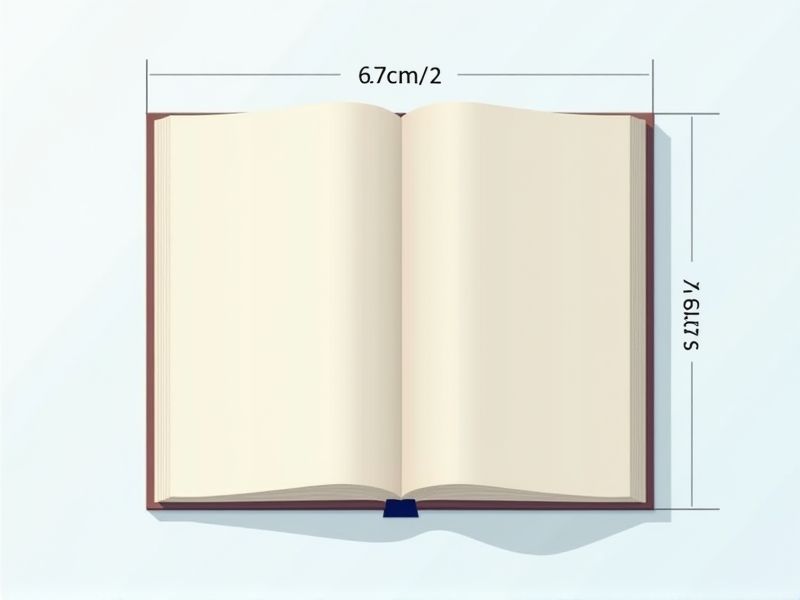
When designing or purchasing a paperback book, it's helpful to know the standard dimensions commonly used in publishing. The most popular size for trade paperbacks is 6" x 9", which provides a balance between portability and readability. For mass-market paperbacks--often found in airports and grocery stores--a smaller size like 4.25" x 7" is typical. Choosing a standard size ensures your book fits on most shelves and meets reader expectations for comfort and handling.
Trim Size
The standard trim size for a paperback book typically measures 5.5 x 8.5 inches, though variations exist, including 6 x 9 inches and 4.25 x 7 inches, catering to different genres and reader preferences. This trim size is favored for its balance between readability and portability, enabling you to easily carry your favorite titles. With an average page count ranging from 200 to 400 pages, these dimensions allow for sufficient content without overwhelming the reader. Properly selecting the trim size is crucial, as it can significantly impact printing costs and marketability in the competitive book industry.
Aspect Ratio
The standard aspect ratio for a paperback book is typically 1.47:1, which translates to a common size of 5.5 x 8.5 inches or 6 x 9 inches. This ratio ensures that the book fits comfortably in hand and is optimal for both readability and portability. When designing your paperback, consider that a balanced aspect ratio enhances the visual appeal of the cover while facilitating a consistent reading experience across various genres. Adhering to these dimensions can also simplify the printing process and improve distribution efficacy.
Bleed Area
A standard paperback book typically requires a bleed area of at least 0.125 inches (3mm) on all sides to ensure that the design extends to the edge after trimming. This means that the total dimensions of your cover design should be larger than the final trim size, accounting for the bleed. For example, if your finished book size is 6 x 9 inches, your cover file should measure 6.125 x 9.125 inches to include the bleed area. Adhering to these specifications ensures that no unwanted white borders appear on the edges of your printed paperback, enhancing the overall visual quality.
Gutter Margin
In a standard paperback book, the gutter margin, which is the inner margin closest to the spine, typically measures between 0.5 to 0.75 inches. This measurement is crucial for ensuring that text is not obscured by binding, allowing for comfortable reading without straining to see the content. Publishers often recommend using a wider gutter margin for thicker books, as they may require up to 1 inch to accommodate the curve of the spine. When formatting your manuscript, adjusting the gutter margin is essential for achieving a professional and accessible layout.
Cover Dimensions
The standard dimensions for a paperback book typically measure 6 inches by 9 inches, providing an ideal size for comfortable reading and portability. This format balances readability with compactness, making it popular among both publishers and readers. For niche markets, you may encounter variations, such as 5.5 inches by 8.5 inches or other custom sizes, enhancing the design's appeal. Ensure that your cover design complements these dimensions, adhering to industry standards for print bleed and margins to achieve a professional finish.
Spine Width
The standard spine width of a paperback book typically ranges from 0.25 inches to 1.25 inches, depending on the number of pages and the paper thickness. For example, a 200-page paperback with standard paper might have a spine width of approximately 0.5 inches. When designing your book, it's crucial to ensure that the spine width accommodates the chosen binding method and paper type to maintain structural integrity. Accurate spine measurements not only enhance the book's aesthetics on shelves but also impact printing costs and formatting.
Safe Zone
The standard dimensions for a paperback book typically range from 5.5 x 8.5 inches to 6 x 9 inches, ensuring an optimal reading experience. A safe zone of at least 0.5 inches from the trim line is recommended for text and essential graphics to prevent accidental cutting during printing. Utilizing a high-quality stock paper, typically around 50# to 70# text weight, enhances durability while maintaining readability. When designing your paperback, keep in mind that a spine width of 0.25 to 2 inches, depending on page count, is crucial for a professional appearance and easy handling.
Page Count
A standard paperback book typically contains between 250 to 400 pages, depending on the genre and formatting. Novels often range from 300 to 350 pages, while shorter works like novellas may have around 100 to 200 pages. For non-fiction, books can exceed 400 pages if they include comprehensive footnotes, references, or illustrations. When choosing a paperback, consider how the page count influences your reading experience and the depth of information presented.
Paper Weight
The standard paper weight for paperback books typically ranges from 70 to 100 grams per square meter (gsm), with 80 gsm being the most common choice for text pages. This weight strikes a balance between durability and readability, ensuring that the pages are thick enough to withstand handling while remaining light enough for comfortable reading. Cover stock generally weighs between 200 and 300 gsm, contributing to the overall sturdiness and tactile feel of the book. Choosing the right paper weight can significantly enhance the aesthetic and functional quality of your paperback, impacting everything from print clarity to reader experience.
Letter Size Adjustment
The standard size of a paperback book typically measures 5.5 x 8.5 inches or 6 x 9 inches, providing an optimal balance between readability and portability. When adjusting letter size, consider using 11 to 12 points for body text, as this range enhances legibility for most readers. Your choice of font can influence the overall aesthetics; for instance, serif fonts are often preferred for longer texts due to their ease of reading. Ensure that the margins are set to at least 0.5 inches to create a clean look and prevent text from being too close to the spine.
